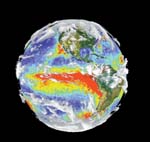| |
Climate Variability and Change
Overview
Recent
Accomplishments
Near-Term Plans
Archived
News Postings [June 2000 - July 2005]
Related
Sites
Calls
for Proposals
CCSP / USGCRP Climate Variability and Change Working Group Members
|
For long term plans, see
chapter on
Climate Variability and Change of the Strategic Plan for the
Climate Change Science Program (2003) posted
on CCSP web site |
|
 |
|
 Recognizing that the climate system operates seamlessly across a wide spectrum of time scales, CCSP- supported research encompasses both short-term climate variability and longer term climate change. Addressing the interaction of climate processes across time scales poses challenges not only in designing observation systems to monitor the climate system adequately, but also in constructing models that can properly reproduce its past and confidently project its future behavior. Earth system models, in combination with global Earth observations, must produce internally consistent maps of atmospheric, oceanic, land surface, and ice conditions both in near real-time and retrospectively. These maps, or “analyses,” will provide decisionmakers with tools to visualize the evolving state of the full climate system over the entire planet, and researchers with the ability to better explain observed changes in the climate system. Recognizing that the climate system operates seamlessly across a wide spectrum of time scales, CCSP- supported research encompasses both short-term climate variability and longer term climate change. Addressing the interaction of climate processes across time scales poses challenges not only in designing observation systems to monitor the climate system adequately, but also in constructing models that can properly reproduce its past and confidently project its future behavior. Earth system models, in combination with global Earth observations, must produce internally consistent maps of atmospheric, oceanic, land surface, and ice conditions both in near real-time and retrospectively. These maps, or “analyses,” will provide decisionmakers with tools to visualize the evolving state of the full climate system over the entire planet, and researchers with the ability to better explain observed changes in the climate system. |
Strategic Research Questions
4.1. To
what extent can uncertainties in model projections due to climate
system feedbacks be reduced?
4.2. How
can predictions of climate variability and projections of climate
change be improved, and what are the limits of their predictability?
4.3. What
is the likelihood of abrupt changes in the climate system such
as the collapse of the ocean thermohaline circulation, inception
of a decades-long mega-drought, or rapid melting of the major
ice sheets?
4.4. How
are extreme events, such as droughts, floods, wildfires, heat
waves, and hurricanes, related to climate variability and change?
4.5. How
can information on climate variability and change be most efficiently
developed, integrated with non-climatic knowledge, and communicated
in order to best serve societal needs?
See Strategic
Plan for the U.S. Climate Change Science Program,
Chapter 4, for detailed discussion of these research questions. |
 Recognizing that the climate system operates seamlessly across time scales, CCSP-
supported research encompasses both short-term climate variability and longer term climate change. The connection between higher frequency fluctuations and climate change is the focus of several recent studies on potential relationships between hurricane activity and long-term increases in tropical sea surface temperatures (see discussion in Analysis of Progress Toward Goals section). Interactions among climate system
components–for example, involving the atmosphere, oceans, land surface, and
cryosphere–are also of fundamental importance to understanding past and projecting future climate changes. Such interactions are vital in explaining past abrupt climate changes, which paleoclimatic evidence suggests have occurred in periods as short as years to decades.1 An important goal of CCSP research is to assess the likelihood of future abrupt climate changes and to identify the requirements for an early warning system to detect and predict such changes. Recognizing that the climate system operates seamlessly across time scales, CCSP-
supported research encompasses both short-term climate variability and longer term climate change. The connection between higher frequency fluctuations and climate change is the focus of several recent studies on potential relationships between hurricane activity and long-term increases in tropical sea surface temperatures (see discussion in Analysis of Progress Toward Goals section). Interactions among climate system
components–for example, involving the atmosphere, oceans, land surface, and
cryosphere–are also of fundamental importance to understanding past and projecting future climate changes. Such interactions are vital in explaining past abrupt climate changes, which paleoclimatic evidence suggests have occurred in periods as short as years to decades.1 An important goal of CCSP research is to assess the likelihood of future abrupt climate changes and to identify the requirements for an early warning system to detect and predict such changes.
Identifying links and feedbacks among climate system components poses challenges
in designing observing systems to monitor the climate system adequately and in
constructing models that can properly reproduce past, and confidently project future, climate system behavior. Toward this end, a new generation of climate models that incorporates improved representations of physical processes, increased resolution, and coupling of the different climate system components is being developed within an Earth system modeling framework. Such Earth system models, in combination with global Earth observations, are essential to produce internally consistent maps of atmospheric, oceanic, land surface, and ice conditions, called "Earth system analyses," both in near real-time and retrospectively. The development of such analyses will
provide decisionmakers with new tools to visualize the evolving state of the full
climate system over the entire planet and provide researchers with the ability to
better explain observed changes.
Research within the Climate Variability and Change (CVC) element focuses on two broad, critically important questions to society as defined in the CCSP Strategic Plan:
- How are climate variables that are important to human and natural systems affected by changes in the Earth system resulting from natural processes and human activities?
- How can emerging scientific findings on climate variability and change be further developed and communicated in order to better serve societal needs?
More specifically, CVC research addresses the five strategic research questions listed at the beginning of this chapter to achieve the milestones, products, and payoffs described in the CCSP Strategic Plan. Cooperative efforts involving CCSP agencies have led to significant progress in addressing all five of the strategic questions articulated in the CVC chapter of the CCSP Strategic Plan. The following section highlights some of the major scientific advances achieved during this past fiscal year.
References
1) NRC, 2002: Abrupt Climate Change: Inevitable Surprises. National Academy Press, Washington, DC, USA, 230 pp.
|
See also:
Climate Variability and Change [also available:
PDF Version]. Chapter 4
from the Strategic Plan for the
Climate Change Science Program (July 2003).
Climate Variability and Change. Presentation from Breakout Session 7
of the US Climate Change Science Program: Planning Workshop for Scientists
and Stakeholders, 3-5 December 2002, Washington, DC.
Climate Variability and Change. Presentation from Breakout Session 13
of the US Climate Change Science Program: Planning Workshop for Scientists
and Stakeholders, 3-5 December 2002, Washington, DC.
Resolution of Disparities in Tropospheric Temperature Records.
Presentation from Breakout Session 15 of the US Climate Change Science
Program: Planning Workshop for Scientists and Stakeholders, 3-5 December
2002, Washington, DC.
Climate Variability -- Atmospheric Composition -- Water Cycle.
Presentation from Breakout Session 19 of the US Climate Change Science
Program: Planning Workshop for Scientists and Stakeholders, 3-5 December
2002, Washington, DC. |
| Note: As
of October 2000, the issues related to
paleoenvironment and paleoclimate are mostly
covered under the broad "Climate
Variability and Change" research
element. However categorized on this web
site, paleoenvironment and paleoclimate
continues to be an important element of global
change research and is essential not just
to our understanding of the past but of future
climate change. |
|
|